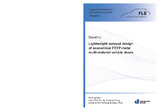Citation link:
http://dx.doi.org/10.25819/ubsi/10028Files in This Item:
| File | Description | Size | Format | |
|---|---|---|---|---|
| FLB_8_Dissertation_Li.pdf | 15.84 MB | Adobe PDF |  View/Open |
| Dokument Type: | Doctoral Thesis | metadata.dc.title: | Lightweight concept design of economical FRTP-metal multi-material vehicle doors | Other Titles: | Leichtbaukonzept für wirtschaftliche FRTP-Metall Multimaterial-Fahrzeugtüren | Authors: | Li, Danshi | Institute: | Institut für Fahrzeugtechnik | Free keywords: | Vehicle door, Lightweight design, Multi-material construction, Fiber-reinforced thermoplastics, Fahrzeugtür, Leichtbau, Multi-Material-Bauweise, Faserverstärkte Thermoplaste | Dewey Decimal Classification: | 620 Ingenieurwissenschaften und zugeordnete Tätigkeiten | GHBS-Clases: | XIWD | Issue Date: | 2021 | Publish Date: | 2021 | Series/Report no.: | Siegener Schriftenreihe Automobiltechnik | Source: | Siegen : universi - Universitätsverlag Siegen, 2021. - ISBN 978-3-96182-113-6 | Abstract: | The vehicle door, as a major steel-intensive closure, can achieve a certain degree of weight-saving potential by the use of lightweight materials and new design principles. Due to the different stiffness and strength requirements on different areas of vehicle doors under static and crash loading conditions, multi-material construction can be one of the most effective ways to achieve lightweight design with minimal additional cost. This work illustrates an approach for the design of economical lightweight multi-material vehicle door concepts based on a market-available steel reference, while considering typical static and crash loading cases. An innovative door structure is introduced that includes a major load-bearing ring structure and a highly function-integrated inner panel. The structure incorporates economical lightweight materials, such as aluminum, long-fiber thermoplastics, and unidirectional tapes, and corresponding mass-production-oriented manufacturing methods. Anisotropy analysis under different loadings guarantees an effective use of unidirectional tapes. Topology and parameter optimizations provide design suggestions for rib structures of long-fiber-reinforced thermoplastics. The final door concepts achieve ca. 20% weight reduction and comparable mechanical performance compared to the steel reference door. Especially for the crash loading case, an innovative component development method is used to validate the final door concepts, which rebuilds the crash behavior close to the full-vehicle scenario with limited surrounding components. Die Fahrzeugtür als große stahlintensive Klappe kann durch den Einsatz von Leichtbaumaterialien und neuen Konstruktionsprinzipien ein gewisses Gewichtseinsparpotenzial erzielen. Aufgrund der unterschiedlichen Steifigkeits- und Festigkeitsanforderungen an unterschiedliche Bereiche von Fahrzeugtüren unter statischen und Crash-Lastfällen kann die Multi-Material-Konstruktion eine der effektivsten Möglichkeiten sein, Leichtbau mit minimalen Zusatzkosten zu erreichen. Diese Arbeit zeigt einen Gestaltungsansatz von wirtschaftlichen Leichtbau-Multimaterial-Fahrzeugtürkonzepten auf Basis einer marktverfügbaren Stahlreferenz unter Berücksichtigung typischer statischer und Crash-Lastfälle. Es wird eine innovative Türstruktur vorgestellt, die eine tragende Ringstruktur und ein hochfunktionsintegriertes Innenblech umfasst. In der Struktur werden wirtschaftliche Leichtbaumaterialien wie Aluminium, langfaserverstärkte Thermoplaste und unidirektionale Tapes sowie entsprechende massenproduktionsorientierte Fertigungsmethoden eingesetzt. Die Anisotropieanalyse unter verschiedenen Belastungen garantiert einen effektiven Einsatz von unidirektionalen Tapes. Topologie- und Parameteroptimierungen liefern Designvorschläge für Rippenstrukturen aus langfaserverstärkten Thermoplasten. Die finalen Türkonzepte erreichen ca. 20% Gewichtsreduzierung und eine vergleichbare mechanische Leistung im Vergleich zur Stahlreferenztür. Speziell für den Crash-Lastfall wird zur Validierung der finalen Türkonzepte eine innovative Komponentenentwicklungsmethode eingesetzt, die das Crashverhalten nahe am Gesamtfahrzeugszenario mit begrenzten Umgebungskomponenten nachbildet. |
DOI: | http://dx.doi.org/10.25819/ubsi/10028 | URN: | urn:nbn:de:hbz:467-21057 | URI: | https://dspace.ub.uni-siegen.de/handle/ubsi/2105 | License: | http://creativecommons.org/licenses/by-sa/4.0/ |
| Appears in Collections: | Universi Hochschulschriften |
This item is protected by original copyright |
Page view(s)
467
checked on Nov 25, 2024
Download(s)
551
checked on Nov 25, 2024
Google ScholarTM
Check
Altmetric
This item is licensed under a Creative Commons License


